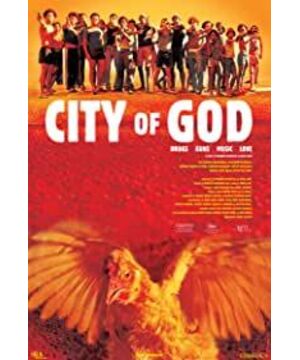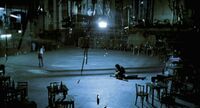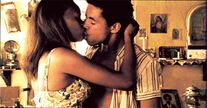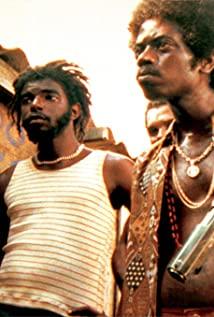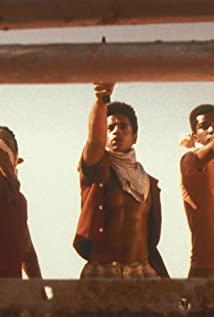The beginning of the shot was cut from a close-up of a sharpening action, and the opening shots used a lot of close-ups: close-ups of sharpening a knife, close-ups of playing the piano, close-ups of drums, close-ups of cutting carrots, close-ups of killing chickens, close-ups of dancing feet Close-ups, close-ups of bartending, close-ups of chicken breaking away from the rope... A series of close-up flashes of movements coupled with background music is a cheerful minor that is unique to Brazil, which makes the opening rhythm very strong. It feels like they are celebrating something, and the atmosphere is very cheerful. However, the switching of all close-ups made people unable to see the unfolding of the storyline, which attracted a strong curiosity of everyone to see exactly how cheerful a scene is... until the chicken broke off the rope and jumped off and picked up a plate of chicken blood. Close-up, and then switched the panoramic view of the chicken escaping from the corner, the Brazilian minor also stopped immediately. The switch from close-up to panoramic view calmed the audience's curiosity and adjusted the rhythm of the film 360 degrees, indicating that the storyline was ready to unfold.
But the opening of the film is not over here. A black man spotted the chicken that had just escaped and shouted to catch the chicken. The director gave a close-up of the black man's face, and a large number of people ran to catch the chicken after hearing his shout. The Brazilian minor started again, lifting the rhythm that had just been slowed down for the audience, and the escape of a chicken began. Chasing from the perspective of the running crowd, shaking hand-held camera close-ups of the escaped chicken, successive quick editing and high-contrast street scenes, cheerful Brazilian minor and the crowd's arrogant and even ignorant laughter, this movie has a strong national atmosphere It makes people want to stop. Seeing this, the film should feel relaxed and cheerful. When a group of young people chasing the chickens pulled out their guns, I began to realize that this movie was not simple.
The camera jumped out of the road with the escaping chickens. The young crowd with guns chased out the road and encountered the main line of the story, A Pao. There were some policemen not far away, but A Pao, who was surrounded by this group of people in the center of the picture, didn’t know. Where to flee. The lens is centered on A Pao, from left to right, and then from right to left, back and forth 180 degrees. Well, we can see that he is in critical condition now. Then the camera turned 360 degrees around him, two full turns. The camera on the first circle was turned to observe the whole situation; the camera on the second circle was turned again, turning back to the 1960s. The story kicked off with a flashback.
The story of three young heroes
The narrative method of the film and the grasp of the large section of the content are in place, and the use of intermediate film techniques, including the title of the short story, including the shooting angle, detailed design, and structural arrangement, are all proficient in place. In terms of structure, the film is broken up, with six or seven stories appearing one after another, but in fact it is complete. The film spans the sixties, seventies and eighties, and a flashback of the camera can traverse one era and perfectly connect the story of the next era.
The film first narrates the story of the three young heroes in the 1960s.
A Pao, this narration-like character, presents this wonderful and shocking real "story" to the audience from his perspective.
The three teenagers in the 1960s had nothing to do. From the perspective of a child, A Pao tells us that the story of the three young heroes is very famous in the City of God. In fact, it's just Tong Yan Wushu. This childish heroic story is just to pave the way for the later story of the little overlord.
In the end, the three young heroes utterly finished the curtain call in A Pao's eyeballs. On the morning A Mao was shot to death by the police, A Pao was on the way to school when a car whizzed past his head. He appeared in front of the camera again and was already a young man. He pursues Anlotika, buys marijuana for her, and smokes marijuana with her. His journey of struggle to change his destiny also only refers to his desire for a camera. When he went to Heizi's apartment to buy marijuana for Anlotika, the next story naturally unfolded.
The story
of the apartment A Pao walked into this apartment and began to tell us the story of this apartment.
This is the most concise story in this movie. The positioning angle of the passage shot, from the deepest part of the apartment to the door of the apartment, the main part of the passage shot is the aisle and the living room in the middle of the apartment. Fixed position and angle, fixed angle of view. Everything happens in the lens: happening, changing, dying, ending, continuing, repeating.
This is also a very indifferent lens language. It's like sitting in front of the window, watching everything that happens outside the window absolutely objectively, watching without moving, no matter how touching the heartstrings of everything that happens in front of the window. Extremely indifferent.
This may also be the longest shot in this movie, not the long shot, but the longest shot in the time span. Directly from the 1960s to the end of the 1970s. Everything. Most of the shots in this paragraph are multi-frame shots, which is more than double the usual 24 frames/S.
It may be said that the several changes of hands in this apartment are the ups and downs in the most corrupt and gloomy world in the city of God. Therefore, the scene of the passage more often means that the city of God is a microcosm of the development model of the drug market from the original individual operation to the later group operation. In this sense, the director has given too many things to this scene.
The shots in this paragraph show more of the director's familiar and super powerful ability to control the shots. The operation of the positioning lens is almost mature in this movie. In my opinion, it is already a classic for positioning lenses.
Okay, here the scene returns to the scene where A Pao finds Heizi to buy marijuana at the beginning of the story, thus smoothly unfolding the next story. Perfect interludes, flawless connection. I have to sigh once again the director's skill in telling stories.
The story of Xiaobawang
All the stories are actually related to this story. In other words, all the stories are actually inextricably implicated, surviving with a continuous break.
A little boy named Xiaodouzi later changed his name to Xiaobawang Hei Man. Throughout the seventies and eighties, he almost dominated the city of God.
In the story of the three young heroes in the 1960s, Xiaodouzi was just a small follower. However, it was he who provided criminal ideas to the young three heroes. And because he was obsessed with the desire to kill, he finally caught the young three heroes to a dead end.
The final plot of the story of the three young heroes is Xiaodouzi's robbery plan for the hour hotel. They didn't kill anyone, it was Xiaodouzi who turned the robbery into a shooting case. And this case is only the first starting point on Xiaodouzi's road to overlordness. He ended the story of the young three heroes and their era ahead of time and brought the entire city of God into another era of gangsters.
The apartment is the epitome of the City of God in the 70s. Xiaodouzi and Barney in the 1970s mixed well, and they had enough criminal talents. The apartment was finally attributed to the era of Xiaobawang, which means that the city of God was basically formed by Xiaobawang's dominance.
The past times are forever gone. The story of the apartment is actually just a footnote in the whole story of Xiaobawang. With the development of the plot of the story, the
intentional crime
finally came to this narrator—A Pao. A Pao is a poor child, at least he has the kindness and qualities of being a good person. However, what can be seen more often in him is a kind of feeble struggle. The intention to commit a crime is because of the predicament of being a good person in the city of God, being bullied, having no way forward, being confused, and worrying forever.
Intentional crime is the fastest way for him to think about how to get rid of the predicament in front of him. His attempts ended in joking failure. A good person can only be a good person after all. He has his own way. In this movie, his Shan Shan Dao fluently and objectively recounts all the changes and development of criminal forces in the city of God from the 1960s to the 1980s. In his body, at least what we see is a flesh-and-blood child who is working hard to improve. The intention to commit a crime is his struggle, and it is also a struggle between good and evil. And he, in this movie, may be the only hope and hope that indifference gives us.
Benny’s Farewell
Party Benny is the coolest gangster in the city of God. Also the best gangster in this town. He is Xiaobawang's best friend and best friend. He and Xiaobawang are two extreme people. He himself plays a buffering and neutralizing role for Xiao Bawang. He is also the sunniest representative of the dark forces in the city of God, and the most crucial figure in the dark forces in the city of God.
He and Xiaobawang have committed crimes since they were young and they shared the country that he and Xiaobawang had fought together, and he and Hongmao are good friends. Therefore, the City of God still has at least a short-term peace under his control. . The city of God is divided into two, and he is the point of check and balance.
Benny is so good that he is not suitable for being a gangster. So he wants to bid farewell to Xiaobawang and his career, and find a farm to smoke marijuana and listen to rock music with his girlfriend.
Light and shadow, frame breaks, editing. The sway at the farewell party was Benny's last carnival. No one wanted him to die, but he died. Innocently resisted a bullet for Xiaobawang. Perhaps, he was the only friend of Xiaobawang, so when he died, Xiaobawang's frantic roar depicted the only warmth of Xiaobawang.
His death is the demise of the check and balance point of the entire city of God. The beginning of the war was closely related to his death. If he doesn't die, the bully will not find Red Hair for revenge, will not meet handsome Ned's girlfriend, will not have blood feuds with handsome Ned, and will not eventually go to war with Red Hair.
Benny’s farewell party may also be the last carnival in the city of God. The farewell party, sent away Benny, also sent away the last patience of Xiaobawang, sent away the good time of Hong Mao and Xiaobawang peaceful coexistence, and also sent away the last quiet and peacefulness of the City of God. After that, the brief peace ended completely.
This story is the biggest turning point in this movie. After that, everything fell.
The story of
Shuai Ned Whether Shuai Ned is a hero, it is difficult to define.
A handsome man, a man who is honestly trying to get rid of the city of God. He went to school, worked as a soldier, practiced karate, the first marksman in the barracks, holding the hope of leaving the city of God and the slums, he finally became a brother in despair.
What we see in him may be a more desperate struggle. He does not like violence, does not like killing, loves peace and love. He also worked hard to maintain his life for this.
However, his efforts were ultimately destroyed by Xiao Bawang's madness.
His struggle lies in his entire process of fall. He joined the Hongmao organization without any choice. Because in the City of God, only Hong Mao can take him in, and Hong Mao is the only remaining force besides Xiao Bawang. And his fall was fully manifested in their three robberies. His fall still has a strong fateful tone, but he eventually became the victim of innocent desire. Handsome Ned is the most desperate symbol in this movie.
The beginning of the end
Finally, the fleeing chicken appeared again in the opening. The background music is still a cheerful tune that is unique to Brazil. However, now I know that as the background music before the gunfire among the gangs, it looks a bit strange, and the shock effect is enhanced. God no longer cares for this fierce and wild city of God, and it has given up the hope of survival, becoming self-willed to fall and sink.
The camera turned 360 degrees again, and A Pao was still in the middle of the party's standoff, and the big rush was about to be staged... His life was quite similar to that chicken. Faced with his companion being slaughtered and scared by the scared chicken, he ran fast. Standing alone and helpless in the middle of the road, when facing forward and backward pursuits, he inadvertently led the person who was going to kill him to a dead end, and fled victoriously by himself. Because he likes photography, the insider allows him to take pictures of gunmen, and the newspaper wins prizes by selling violent insider stories.
In the movie, the shutter is pressed like a gunshot, and it is also like freezing and zooming in to interpret the meaning of life.
The film also uses traditional shooting techniques, Latin American sunshine, poor and colorful, natural and man-made landscapes squeeze each other, this part of the very tonal picture, and the detailed characterization, and the documentary style part are wonderfully harmonious.
I really admire the gorgeous images and fancy and dynamic lens editing methods used by the director. There are psychedelic MTV-style clips in the film, shaking portable camera lens, 360-degree rotation and revolution lens, fast switching lens, jumping and flashing lens, close-up, shaking lens, etc., which makes people very dizzy. Set off the smoothness and crispness of the plot of the film. The empty camera shows the incredible dark slum of the Jewish Quarter of De Janeiro to the eyes of the world. Violent but not bloody; heavy but not pretending; artistic and real; long but clear; characters are many but not chaotic, the plot is complicated but not sloppy; the span is long but not drowsy, the color is dark but does not pollute the sight. You can think of the main line as the line where A Pao escapes from the city of God, or as the line where the little overlord goes to extinction.
This movie is just as beautiful as an essay that makes me admire, of course, this refers to the storytelling structure of the movie itself. The shape is scattered and gathered together. The seemingly disorganized mode tells several stories from the perspective of the third person. Several protagonists take turns playing, connecting all the stories in a delicate, obvious but hidden way. Therefore, under the scattered structure, there are more detailed and delicate calculations than straightforward descriptions. There are many small places, and only when I look back, I realized it. Many episodes seem too dramatic, and perhaps that is the intention of the director's deliberate the fate of prominent of all are intertwined with
the film's screenplay is very elegant and unconventional. The way of telling stories is very close to art. This is the highlight of this movie.
View more about City of God reviews


